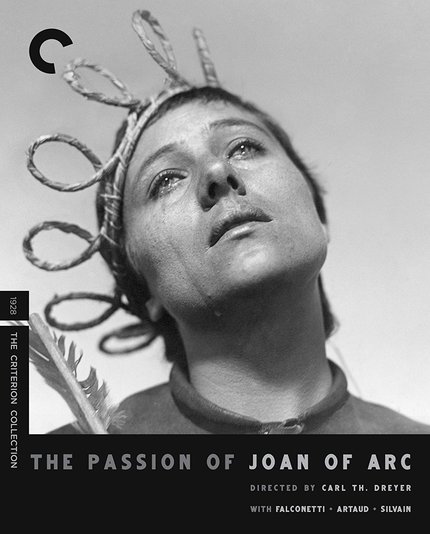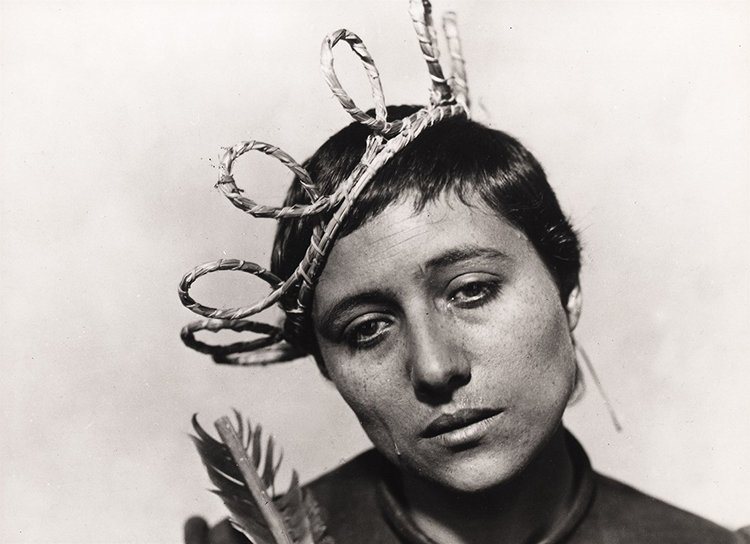Blu-ray Review: Criterion's THE PASSION OF JOAN OF ARC Keeps the Faith
Carl Theodore Dreyer's historic silent classic, starring Renée Falconeti, shines on Blu-ray.

I couldn’t go to church on the evening of Good Friday this year, so instead I watched The Passion of Joan of Arc. The choice was solid, for a number of reasons.
I watched the completely silent version, said to be the preferred version of its director, Carl Theodore Dreyer, shown at 20fps. Silence behooves the 1928 classic, itself a striking, unforgettable vision, however one may experience it.
That said, this is a film that lends itself to a multitude of musical accompaniments, an attribute that Criterion has decidedly utilized with their newly issued Blu-ray upgrade of their initial 1999 DVD release. There are no less than three score options on this disc, each a distinct and worthy experience. One is a more conventional silent era one-man effort by pianist and composer Mie Yanashita. Another more avant-garde score is by Will Gregory of the band Goldfrapp and Adrian Utley of the band Portishead. Finally, there’s “Voices of Light,” Richard Einhorn’s opera/oratorio that’s often performed with The Passion of Joan of Arc.
Besides the music, or lack thereof, the disc also allows for viewing the film at either 24 frames per second (the standard projection frame rate that filmmaking the world over eventually settled into) or an earlier 20 frames per second option. In an explanatory bonus video, the case is made as to why, to the his day, there is no definitive frame rate. This is the case for many films of the silent era, even major ones such as this. In truth, the speed variations are not tremendously discernible, though Criterion impressively bows to both options, each having its own defenders. It is the 24fps version, however, that has received the 2K digital restoration by Gaumont. The 20fps version features the original Danish intertitles. Per the speed variations, various scores are not interchangeable with the two different frame rate options.
Although the review of this disc has occasioned multiple viewings, each one tweaked a bit differently, I’d never seen the film prior. Despite harvesting a bounty of world cinema of all eras on disc over the past twenty years, and having attained a degree in film, The Passion of Joan of Arc somehow eluded me. Even as its reputation rightly burned bright, rumblings of an extensive restoration left me justifying the wait. For years.
Finally, the wait for a revised Criterion edition of Dreyer’s most well-known and respected film is over. It must be said that The Passion of Joan of Arc is every bit the intense immersion into a singular vision of 500-years-ago sickly corrupt justice and religious patriarchy run amok. It’s breathtaking how Dreyer does so much with what is essentially a strict depiction, word for word, of St. Joan’s trial that led to her capital punishment: being burned alive at the stake.
She was only 19 years old, a simple French farm girl who claimed to be led into battle for her country, against the occupying English, by the voice of God. Her major victories during the Hundred Years’ War, coupled with her subsequent martyrdom, and, 500 years later, sainthood, ascended her to the level of French folk hero and symbol of national pride.
The Catholic Church, sympathetic to the English then, wielded great authority in Joan’s day. It lorded over the French state while first and foremost clinging to their power, among the greatest things that Christ specifically taught not to do. The hypocrisy and fear that hubris’ its way to their seat of authority is intentionally played out by the devoutly Christian Dreyer as reflective of the Pharisees' judgement against Christ, centuries earlier. The one thing that most threatens their order is the one thing they’ve forgotten that their order is based upon: supernatural mystery, typically embodied and/or deployed where anyone least expects it.
There have, of course, been many films made about Joan of Arc, most portraying her armor-clad conquests in battle. At least one of these was produced concurrently with this film, at a time when she was all the rage, having finally been granted sainthood by the very Catholic Church that once condemned her. The marvel of Dreyer’s all-trial version of her story is how a “pure cinema” approach and his no-compromise attack on the material results, nonetheless, in this talk-heavy (although silent, with choice intertitles) and battle-free version becoming the definitive Joan of Arc film.
Dreyer has crafted a lucid, fevered look at the historical trial of Joan before the archbishops and the rest. By opting for distorted, odd, never-repeated angles of the questioners, the viewer is thrust into the starved, delirious headspace of our doomed protagonist. By contrast, for the first nearly twenty minutes, most cutaways to Joan are the same, stable and conventionally framed shot. This is a cue, surely subconscious to many, that Joan is the trustworthy and sympathetic one in this torchlit concrete horror show.
That so much of it is realized in close-up is another artistic leap that flies in the face of conventional filmmaking wisdom, even today. Yet, there’s nothing “televisual” (to use an anachronistic-for-1928 term) about The Passion of Joan of Arc, itself one of the largest scale and grandest film productions of the time.
Rigidly insisting upon historic accuracy in terms of heavy building materials and hairstyles, not to mention his word-for-word use of the actual trial dialogue, Dreyer made few friends with his cast and crew as the shoot wore on for many months. But even still, Dreyer took liberties, both necessary (compressing the timeline of real events) and curious (someone is shown wearing glasses). Clearly, before there was David Fincher, there was Carl Theodore Dreyer.
And then there’s Renée Falconeti. Her character, wide-eyed and at wits-end, is the very portrait of tortured, youthful dignity. That she’s also the portrait of saintly, beautiful androgyny makes her intensely felt performance all the more beguiling. Surrounded by diamond spearheads and aged holy fossil men that abruptly sling into frame and exist creature-like on a canted plane, Falconetti’s Joan is both the quivering vulnerable girl at a loss for words, and a hardened warrior of the field. She is a medieval fresco in a toxic gallery.
That they expect Joan to articulate a most internal, personal experience -- a visitation by an archangel -- only goes to show how out of touch the church had to have been. At least, that’s how Falconetti sells it. She would forever be known for this film role... and no others. Her uncanniness is something that, on this level, burned into celluloid once, and once only. A stage performer extraordinaire, as far as cinema is concerned, Falconetti billowed away in the wind when her character burned.
The accompanying booklet is a healthy one, containing an enlightening essay by film book author Mark Le Fanu. Then, there’s a brief piece by Dreyer himself, intended for French audiences at the time of the film’s debut. Also included are several pages of the text of “Voices of Light”.
Further disc extras include the 1999 audio commentary by Casper Tybjerg; a new interview with Richard Einhorn, a new semi-brief conversation between musicians Will Gregory and Adrian Utley; the aforementioned short frame rate explanation video, by Tybjerg; a longish 1995 video interview about Renée Falconetti with the actress’s daughter; version history; trailer; a production design archive; and new English subtitle translations.
It’s time to stop paying penance for having only now seen The Passion of Joan of Arc, and begin paying penance for this review turning up a little late. That stated, considering all of the options Criterion offers on their long awaited and definitive Blu-ray edition, one can only be so sorry.
Despite its silence and religious themes, this is a film that remains vital, and unquestionably resonates. Not only is it the crowning work of an a auteur who operated nearly as defiantly as his title character, The Passion of Joan of Arc signals that the nature of the ruling order, itself willing to commit horrendous acts in the interest of maintaining power, hasn’t changed all that much. Through Dreyer’s film, particularly as issued by Criterion, we have continuing inspiration to stand up when necessary, and, regardless, to always keep the faith.








